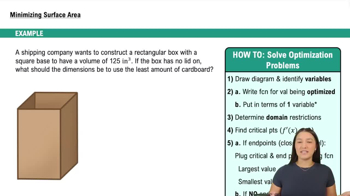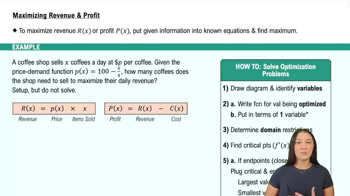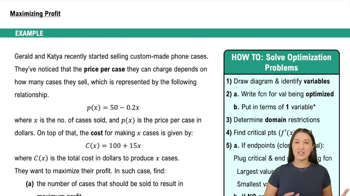Table of contents
- 0. Functions7h 52m
- Introduction to Functions16m
- Piecewise Functions10m
- Properties of Functions9m
- Common Functions1h 8m
- Transformations5m
- Combining Functions27m
- Exponent rules32m
- Exponential Functions28m
- Logarithmic Functions24m
- Properties of Logarithms34m
- Exponential & Logarithmic Equations35m
- Introduction to Trigonometric Functions38m
- Graphs of Trigonometric Functions44m
- Trigonometric Identities47m
- Inverse Trigonometric Functions48m
- 1. Limits and Continuity2h 2m
- 2. Intro to Derivatives1h 33m
- 3. Techniques of Differentiation3h 18m
- 4. Applications of Derivatives2h 38m
- 5. Graphical Applications of Derivatives6h 2m
- 6. Derivatives of Inverse, Exponential, & Logarithmic Functions2h 37m
- 7. Antiderivatives & Indefinite Integrals1h 26m
- 8. Definite Integrals3h 25m
5. Graphical Applications of Derivatives
Applied Optimization
Problem 4.R.44
Textbook Question
Minimum painting surface A metal cistern in the shape of a right circular cylinder with volume V = 50 m³ needs to be painted each year to reduce corrosion. The paint is applied only to surfaces exposed to the elements (the outside cylinder wall and the circular top). Find the dimensions r and h of the cylinder that minimize the area of the painted surfaces.
 Verified step by step guidance
Verified step by step guidance1
Identify the variables: Let r be the radius and h be the height of the cylinder. The volume of the cylinder is given by the formula V = πr²h.
Set up the volume constraint: Since the volume V is given as 50 m³, we can express this as πr²h = 50, which allows us to express h in terms of r: h = 50/(πr²).
Determine the surface area to be minimized: The surface area A to be painted consists of the lateral area of the cylinder and the area of the top. The formula for the surface area is A = 2πrh + πr².
Substitute h in the surface area formula: Replace h in the surface area equation with the expression found from the volume constraint to get A in terms of r only: A = 2πr(50/(πr²)) + πr².
Differentiate the surface area function A with respect to r, set the derivative equal to zero, and solve for r to find the critical points that minimize the surface area.
Was this helpful?

 1:13m
1:13mWatch next
Master Intro to Applied Optimization: Maximizing Area with a bite sized video explanation from Callie
Start learningRelated Videos
Related Practice









